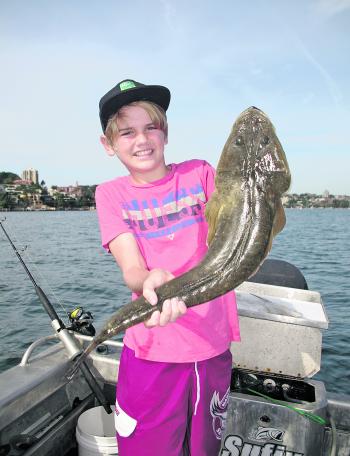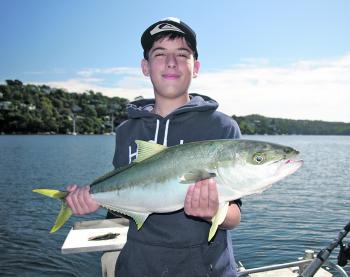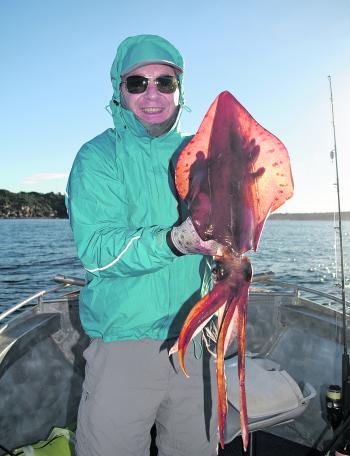With the warm currents retreating north so slowly this year, it’s anyone’s guess what this month will bring. We are still catching kingfish, there has been a good run of sub-surface salmon, lots of big tailor, fantastic big flathead and plenty of leatherjackets. Blue swimmer crabs have been grabbing baits and while they are not in numbers, they are very big. This is also the time of year for huge squid.
Jacket numbers seem to be better than they have ever been. This is possibly due to the vastly increased habitat and food supply created by manmade structure. There’s at least 10 different species of leatherjacket available to harbour, bay and offshore anglers and most can be caught all year round, but are a particularly great stand-by for the slow days in winter.
They cover a wide range of habitats from well up into the estuaries to the open sea and can be relied on even when all other species have gone off the bite. Although not generally highly regarded as a sportfish, they do give a good tussle on light line. They are very accessible and delectable on the plate. They are also very high in those healthy omega 3 fats.
Good spots to try include around bridge pylons, marinas, jetties, reefs and rocky points. They love tiny pieces of prawn bait and, as they have a very small mouth, hooks need to be kept small. Fish your baits about 1m off the bottom and wait until you feel that slow suck characteristic of ‘jackets’. Don’t strike immediately, wait a few seconds to let them get it into their tiny mouth.
There has been a good showing of salmon but they are deep and are mainly being caught on baits and trolling deep divers.
Most people I know would rather cast to salmon than troll for them. What do you do though if you want to cast a lure or fly to pelagics but can’t them on the surface? Troll until you find them and then cast. Trolling lures is a legitimate fish finding tool, even if you do not like or intend to catch them this way.
Trolling the headlands, particularly North, South and Middle heads is the preferred option when the fish or the baitfish cannot be visually or electronically located in open water. Of course, with their highly mobile nature, salmon can be expected to turn up anywhere and we have even caught them as far upstream as Bantry Bay in Middle Harbour.
In fact, strong concentrations of baitfish have been known to lead them well up into the mangrove country, but this is the exception rather than the rule.
Trolling is best done with minnow style lures. Metal baitfish profiles and skirted type lures the likes of Christmas trees are good when the fish are high up in the water. Those types of lures will ride high at the trolling speeds required for pelagics (4-6 knots). Minnows offer deep diving capabilities or at least reliable depth control.
A trolling pattern must be established in order to locate the concentrations of fish. This usually involves a close run first and then moving a little bit wider on each run after that. Troll both directions on each run, because it’s common to find fish biting in one direction and not the other. Keep an eye on your sounder for baitfish concentrations, other boats trolling to see where and what they are catching and so you don’t run into them, birds working the surface, current lines and most importantly, gnarly waves and bommies.
There is some good squid around at the moment but they are generally sitting in much deeper water than you would normally find them in the summer months. Work big jigs and keep them deep. You will find them at your normal squidding spots, but instead of casting towards the shore as you would in summer, try casting to the deep water on the blind side.
AUTHOR’S OPINION
Sydney Marine Parks update
To give you an idea of how recreational fishing is doing in the Sydney Marine Parks debate, rec fishing is listed alongside recreation and tourism as ‘high risk’ activities by the marine estate management authority (MEMA). To put this into perspective, commercial fishing is listed as ‘medium risk’. And according to MEMA the risk posed by recreation and tourism are increasing while the risk from commercial fishing is decreasing. Divers (recreational diving) are not listed at all, which is interesting, as they are one of the main lobby groups pushing for angler lock-outs.
Chowder Bay (Clifton Gardens) is one of the 15 sites listed by MEMA earmarked for lock-outs. Chowder Bay is a small bay of which approximately half its area is taken up by a major navy refuelling facility. I don’t know what MEMA has set down as an assessment criterion for suitability for a marine park, but I can’t imagine having a working shipping refuelling facility, taking up half of the proposed marine park area would fit the equation. Could it have something to do with the commercial dive business working in the bay? Chowder Bay jetty is one of most popular land-based fishing sites in the harbour that is both kid safe and suitable for disabled anglers.
Manly shire residents, who lost a huge chunk of safe, shore-based fishing coastline in the form of Cabbage Tree Bay reserve (angler lock-out zone) should be aware that all of North Harbour has also been earmarked for lock out. If that goes ahead then that’s all of Manly’s safe, kid friendly fishing shoreline gone. This lock out will also include the site known as the ‘old gas works’, which is one of the few access points for fishers with disabilities
Divers and green groups are trying to sell us the line that we can expect ‘better fishing’ from the ‘spill over effects’ of marine parks. That is to say that fishing everywhere will be better as a result of fish ‘spilling over’ out of the marine parks. Worldwide studies on marine park ‘spill over’ has generally shown little to no spill over from parks under 10 thousand hectares. The biggest park proposed by MEMA is one and a half thousand hectares. In fact, if you combine all 15 of MEMA’s proposed parks it doesn’t even come close to 10 thousand hectares. Furthermore, even in the large functioning marine parks, spill over has shown to extend only a few hundred meters from the park boundary.
We need to do something as a body. If we don’t, we may wake up to a ‘NO FISHING’ sign.
Referenceshttp://saveourmarinelife.org.au/wp-content/uploads/2015/06/mpa-review.pdf http://www.marine.nsw.gov.au/__data/assets/pdf_file/0009/595044/hawkesbury-shelf-discussion-paper.pdf
Reads: 2444
Now is the best time of year to target big flatties.

There are plenty of salmon around, but you will need to fish deep to find them.

Kings are lingering well into winter this year!

Succulent blue swimmer crabs will be around for the next few months, so get excited!

There’ll be plenty of Krakens getting around, so break out the jigs and target the deeper water.

Jackets are a great winter stand-by if your usual quarry isn’t playing the game.




